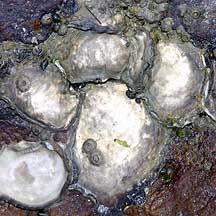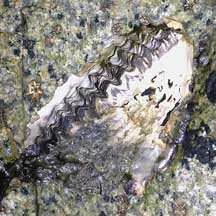 |
|
| bivalves text index | photo index |
| Phylum Mollusca > Class Bivalvia |
| True
oysters Family Ostreidae updated May 2020
Where seen? Among our favourite seafood, oysters are often over-collected on some of our more accessible shores. Sometimes, they are merely vandalised by thoughtless visitors. They are common on the rocks and other hard surfaces of many of our shores. What are true oysters? True oysters belong to the Family Osteridae. Features: The two-part shell is thick and chalky. In true oysters, the left valve is glued firmly to a hard surface. What we see is the right valve. A layer of barnacles and algae often eventually develops over the right valve so that the oyster becomes hard to distinguish from the rock. Some oysters have spikes on this valve, probably to deter predators such as drills. Other bivalves usually have a foot, to dig with or move about. Being immobile as adults, oysters have lost their foot. It is hard to distinguish oyster species by their shell shape alone. Their shells can take different shapes depending on the conditions they live in. They are usually identified by internal features of the shell and animal. On this website, they are grouped by external features for convenience of display. Sometimes mistaken for limpets or barnacles. Here's more on how to tell apart shelled animals found on the rocks. |
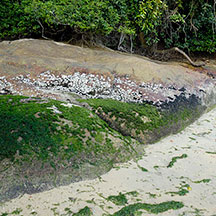 Oysters often form a distint band on hard surfaces near the high water mark. Chek Jawa, Jan 08 |
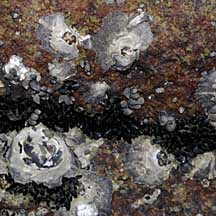 All kinds of different animals may settle among the oysters. Chek Jawa, Jan 08 |
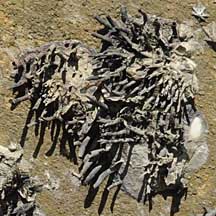 Some oysters have spikes on their shells, perhaps to deter predators. Berlayar Creek, Mar 09 |
| What do they eat? Like
most other bivalves, oysters are filter feeders.
When submerged, an oyster opens its valves slightly and sucks in a
current of water. It uses its enlarged gills to sieve food particles
out of this current. When the tide goes out, it clamps up the valves
tightly to prevent water loss. Oyster babies: Oysters may produce eggs or larvae. Some species may change gender while others are simlutaneous hermaprodites being predominantly male or female depending on the temperature of their environment and availability of food. Human uses: Oysters are relished by people everywhere as a delicacy. They are also believed to have aphrodisiac properties in some cultures. Like other filter-feeding clams, however, oysters may be affected by red tide and other harmful algal blooms when they are then harmful to eat. Oyster farming: Oysters have been farmed for centuries. Basically, young oysters are kept in cages or mesh bags and left in the sea until they were large enough for market. It is believed that farming oysters for their flesh happened together with farming them for their pearls. Got pearl inside? Valuable pearls are found in only a small group of oysters. While other kinds of oysters (and even snails) may produce pearls, these are often not pretty enough to be of commercial value. So please DO NOT vandalise our oysters in the vain hope of finding a valuable pearl. Status and threats: None of our oysters are listed among the threatened animals of Singapore. However, like other creatures of the intertidal zone, they are affected by human activities such as reclamation and pollution. Trampling by careless visitors and over-collection can also affect local populations of young clams. Oysters on disturbed shores are often vandalised by thoughtless people. |
| Some True oysters on Singapore shores |
| Family
Ostreidae recorded for Singapore from Tan Siong Kiat and Henrietta P. M. Woo, 2010 Preliminary Checklist of The Molluscs of Singapore. ^from WORMS
|
Links
|
